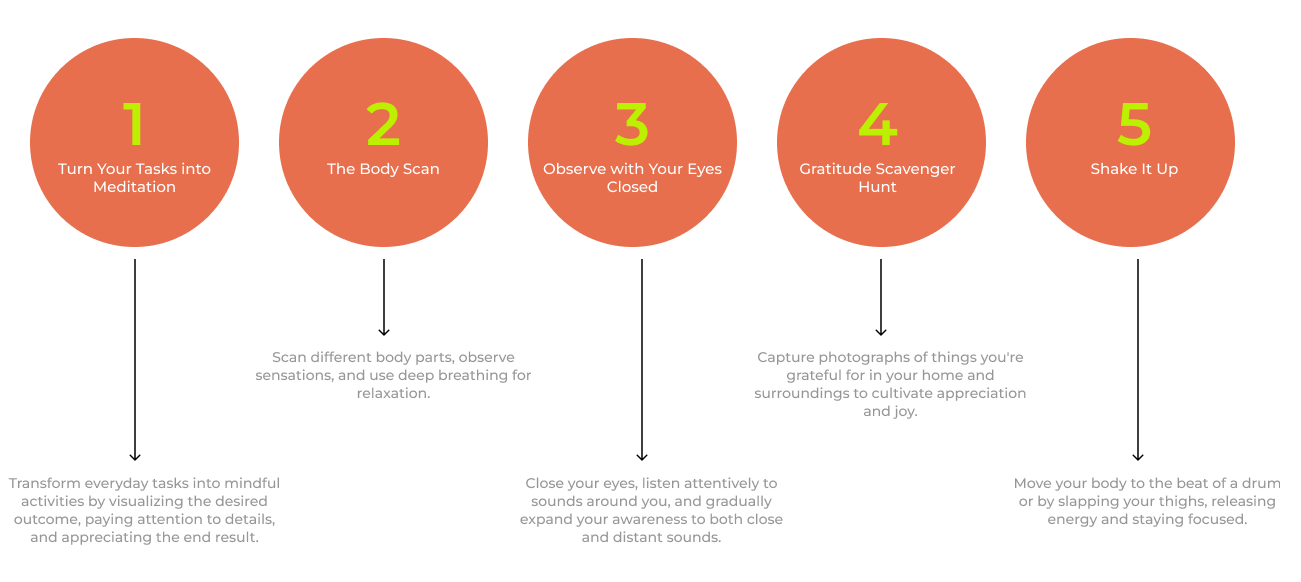
Mind
A Mindfulness Application for Teenagers / User Experience Design
MY ROLE
UX Research
Concept Development
Journey Mapping
Strategic Thinking
Prototyping
Design System
TOOLS USED
Adobe XD
Adobe Illustrator
Adobe Photoshop
TEAM
Solo
TIMELINE
15 Weeks
BACKGROUND
About Mind
"Designing an application for children to help them practice mindfulness"
Client: Radhika Rai, a mindfulness instructor in India who specifically works with kids. Her mission is to make children emotionally more intelligent and resilient.
Target group: Teenagers aged 13-17 years.
The application is being created for the client so that she can impact more lives through the app than she is able to do in person through one-on-one counselling.
Aim: Building emotionally resilient kids of the future.
BACKGROUND RESEARCH
What is Mindfulness?
Mindfulness means living in the present moment. It means being more aware and awake to each moment and being fully engaged in what is happening in one's surroundings – with acceptance and without judgment. It helps build key skills like focus and self-control. It improves physical and mental health and increases intellectual skills. It can teach us to view our thoughts in a more neutral manner and keep our emotions in check.
What is Emotional Resilience?
Emotional resilience refers to the ability to navigate challenging situations in a healthy manner. Resilience is typically defined as the capacity to endure difficult times and bounce back in a positive and adaptive manner.
USER STUDY
What Teenagers?
> At this age, abilities and skill levels significantly influence self-image.
> Academic pressure is high, and there is often resistance between parents and the desire for autonomy in various aspects.
> Early or late onset of puberty can result in feelings of awkwardness and negatively affect confidence.
> Societal influences exert a strong impact.
PROBLEM DISCOVERY
Problem Statement
Teenagers often face a busy schedule that hinders their ability to have a refreshing day. They find exercise and physical activities to be tedious and boring, and even when they make an effort, there is a lack of motivation due to various concerns in their everyday lives.

SOLUTION DISCOVERY
Hypothesis
Integrating mindfulness into the everyday life of a teenager can help them deal with stressful and challenging situations by developing a calm mindset. Additionally, it can enhance their emotional quotient, making them more resilient in the face of difficult emotions and situations.
STRATEGY & PLANNING
Research Plan
> OVERVIEW: The research aims to develop an application for teenagers to assist them in practising mindfulness and dealing with their everyday challenges. The goal is to cultivate awareness and an open-minded mindset, emphasizing the importance of mindfulness without imposing it forcefully.
> METHODOLOGY: The methodology outlined for the research were surveys, interviews of teenagers and their parents, and spending a day in the life of teenagers to understand their routines, emotions/moods and concerns throughout the day.
> PARTICIPANT CRITERIA: The user study will involve four participants, consisting of two boys and two girls from two distinct age groups, who do not currently practice mindfulness. This selection aims to bring depth and diversity to the project.
> RESEARCH GOALS: The research aims to understand the motivations, beliefs, moods, emotions, scenarios, and environments of the target audience, where mindfulness can serve as a valuable tool.
SEMI-STRUCTURED INTERVIEWS
Ethnography Research
Purpose: The research activity, titled "A Day in the Life of a Teenager," is a semi-structured interview aimed at achieving the following objectives:
Identifying moods and activities: Spending the day with teenagers seeks to uncover the range of moods experienced by teenagers throughout their day and understand the various activities they engage in.
Creating a user journey: A user journey was constructed, mapping out the typical experiences, emotions, and challenges faced by teenagers during different parts of their day. This user journey will serve as a foundation for identifying key touchpoints for potential design interventions.
ETHNOGRAPHY RESEARCH
Research Activity
Activities were conducted with teenagers using an activity book to elicit their emotional experiences and reflections. They described their emotions, thoughts, actions, consequences, challenges, and future approaches to similar situations. The goals were to gain insights into teenagers' emotional experiences, perception of situations, and decision-making processes. The activity aimed to identify common challenges and coping strategies among teenagers.
USER STUDY
Interviews & Survey
The purpose of the interview and survey identifies how teenagers respond to different concerns in their daily lives and what strategies or factors help them to effectively cope with these challenges.
USER RESEARCH SYNTHESIS
Actionable Insights
During the primary research conducted, the following list of concerns emerged as common challenges faced by teenagers in their everyday lives, whether knowingly or unknowingly. These concerns form the foundation for the development of an application to help them cultivate mindfulness:
> Struggling to sleep
> Performance anxiety
> Lack of patience
> Gratitude (being thankful for the good)
> Difficulty in making new friends
> Lack of self-control
> Short temper
> Reacting to situations without thinking
> Overthinking
> Time management issues
> Lack of physical activity
> Fatigue
USER STUDY
User Persona
RESEARCH
Competitive Analysis
> User Experience: All apps prioritize simplicity, intuitive navigation, and visually appealing designs to create a calming and immersive environment.
> Content Variety: There may be potential for further diversification in terms of interactive features and additional mindfulness practices.
> Interactive elements: There is a potential opportunity to incorporate more interactive elements to engage users actively in their mindfulness practice.
> Pricing Models: Apps employ a combination of free access to basic features and premium content through subscription plans. Considering affordability and exploring alternative pricing options could be beneficial.
USER RESEARCH
Empathy Mapping
Based on the research, an empathy map was created to understand the usability of the application from the user's point of view
SUMMARY OF SYNTHESIS
Actionable Insights
> Benefits of Mindfulness: Teenagers express a desire to understand how mindfulness can address their specific concerns and provide benefits in their daily lives.
> Incentives: Teenagers respond positively to incentives or rewards that motivate them to practice mindfulness.
> Time Availability: Mornings and evenings are the periods when teenagers have relatively more free time for engaging in mindfulness activities.
> Non-Forceful Approach: Teenagers prefer an approach that avoids forceful or unnecessary commands and instead focuses on encouraging and guiding their mindfulness practice.
SOLUTION DISCOVERY
Identifying Exercises
Drawing insights from both primary and secondary research, identifying exercises for the mindfulness application commenced by consulting various books and resources. The target audience and the intended purpose of the application guided the selection of exercises. The resulting structure of exercises was thoughtfully crafted to cater to the specific needs and goals of the users.
Breathing exercises: Involving the entire body during the process of breathing.
Mindful movements: Allowing the body to release tension through whole-body exercises.
Kindness and Gratitude: Teaching gratitude through mindfulness practices.
Mirror exercises: Daily affirmations for a positive self-image.
Mood monitoring: Tracking and reflecting on daily emotions.
SOLUTION DISCOVERY
Information Architecture
SOLUTION DISCOVERY
The System
The system created for the application is designed to address the focus area of gaining awareness of emotions. It serves as the base structure for the flow of exercises within the app, providing a consistent and cohesive experience for users. The system incorporates various aspects of visualization to enhance the exercises' effectiveness.
Within this system, five exercises have been identified to demonstrate the flow and structure. Each exercise targets different aspects of mindfulness and engages users in specific activities. The exercises include:
SOLUTION DISCOVERY
Sketches & Wireframes
To bring the app's concept to life, I embarked on the process of developing low-fi and mid-fi sketches. These sketches allowed me to explore and visualize various design concepts specifically tailored to the app's exercises and features.

SOLUTION DISCOVERY
Product Differentiation
Selection of Exercises: The app offers a unique and curated selection of exercises targeting mindfulness and emotional well-being.
Tips and Tricks: Besides exercises, the app provides users with helpful tips and tricks to enhance their mindfulness practice and make it more effective.
Incentive/Reward System: The app incorporates an incentive/reward system in the form of mindful badges. There are 15 mindful topics in the application, each represented by a badge. Users receive an empty badge upon completing an exercise on a specific topic. By consistently performing exercises, users can fill out the badge, and once filled in, a new badge is added to their collection. The aim is to encourage ongoing engagement and make the mindfulness journey rewarding.
HOW MIGHT WE?
Design engaging exercise solutions for busy teenagers, addressing concerns and promoting seamless integration into their schedules for a refreshing day.
.
The Product
SOLUTION DISCOVERY
THE PRODUCT
The Focus 1: Exercises
Solution: The exercises transform physical activities into engaging experiences for teenagers, addressing their concerns and motivating them to incorporate these activities seamlessly into their busy schedules. Through techniques like breathing exercises, mindful movements, kindness and gratitude practices, and mirror exercises, they cultivate mindfulness, self-awareness, and a positive mindset for a healthier lifestyle.
Solution: The app includes a reward system with mindful badges. Users can earn badges by completing exercises related to the 15 mindful topics in the app. Filling out a badge through consistent exercise unlocks new badges, providing ongoing motivation and rewards in the mindfulness journey.
Reward System
THE PRODUCT
Solution: The profile section consists of three categories:
Progress: This category displays the overall progress of the user in terms of mindfulness exercises and activities. It provides information on the total minutes practised, the longest streak maintained, and the number of sessions completed.
Journey: In this category, users can track their mood monitoring progress through weekly graphs. It also provides personalized tips and suggestions based on the user's mood data.
Badges: This category showcases the number of badges unlocked by the user, representing their achievements in the mindfulness journey.
Profile
THE PRODUCT
Design System
VISUAL DESIGN
Next Steps
> Visualization: Enhance the visual representation of exercises for improved user understanding.
> Integration: Incorporate smartwatch functionality for seamless on-the-go usage.
> Testing: Conduct rigorous hi-fi testing to identify and address any potential issues.
> Interactivity: Improve interface interactivity and incorporate engaging animations to captivate users.
Learnings
> Market analysis and positioning: A thorough understanding of the market and target audience was gained, allowing for strategic positioning of the app to differentiate it from existing competitors and cater to the unique needs of teenagers.
> Leadership and decision-making in design: The project provided an opportunity to take on leadership roles, make critical design decisions, and guide the development of the mindfulness application.
> Problem identification: Through in-depth research, the project enabled the identification of a specific problem statement related to teenagers' lack of motivation for exercise and physical activities.
> Collaboration with industry professionals: Engaging in discussions with professionals in the fields of mindfulness, psychology, and education helped gather valuable insights and ensure the app's effectiveness and relevance.























